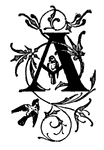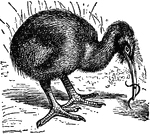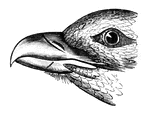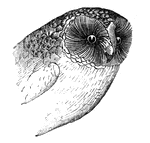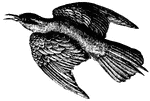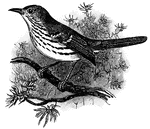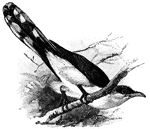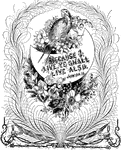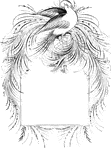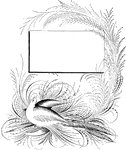
Wandering Albatros
"The Wandering Albatros of the Southern Oceans is white with narrow dusky undulations above and almost…
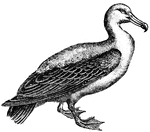
Albatross
The Albatross is the largest and most bulky of all the birds which fly over the surface of the sea.
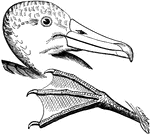
Bill and Foot of a Short-tailed Albatross
"Diomedea brachyura. Short-tailed Albatross. Bill 5.00 or 6.00 inches long, with long, with moderately…

Sooty Albatross
"Phoibetria fuliginosa. Sooty Albatross. Plumage ordinarily uniform sooty-brown; quills and tail blackish…
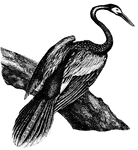
Anhinga
The head of the anhinga is slender and cylindrical, on a slim and excessively long neck, which makes…

Smooth-billed Ani
"Crotophaga ani. Smooth-billed Ani. Black Witch. Savanna Blackbird. Bill smooth or with a few transverse;…
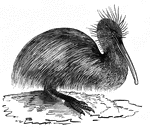
Apteryx
The Apteryx is characterized by the rudimentary condition of the wings, which are useless as organs…
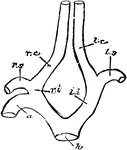
Carotid Arteries of Birds
"h, root of aorta; 1, arch of aorta, to the right side; li, left innominate; ri, innominate; ls, left…

Carotid Arteries of Birds
"h, root of aorta; 1, arch of aorta, to the right side; li, left innominate; ri, innominate; ls, left…
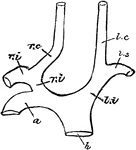
Carotid Arteries of Birds
"h, root of aorta; 1, arch of aorta, to the right side; li, left innominate; ri, innominate; ls, left…
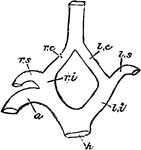
Carotid Arteries of Birds
"h, root of aorta; 1, arch of aorta, to the right side; li, left innominate; ri, innominate; ls, left…
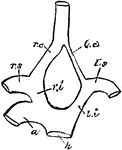
Carotid Arteries of Birds
"h, root of aorta; 1, arch of aorta, to the right side; li, left innominate; ri, innominate; ls, left…

Carotid Arteries of Birds
"h, root of aorta; 1, arch of aorta, to the right side; li, left innominate; ri, innominate; ls, left…

Least Auk Adult
"Simorhynchus pusillus. Least Auk. Knob-nosed Auk. Bill small and simple. but stout for its length,…
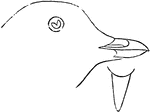
Least Auk Adult
"Simorhynchus pusillus. Least Auk. Knob-nosed Auk. Bill small and simple. but stout for its length,…
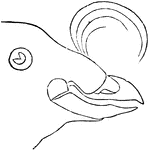
Crested Auk in Summer
"Simorhynchus cristatellus. Crested Auk. Snub-nosed Auk. Bill fundamentally small and simple, compressed-conic,…

Horn-billed Auk in Summer
"Ceratorhina monocerata. Unicorn Auk. Horn-bill Auk. Adults in summer: Bill orange-yellow. Culmen and…

Crested Auk in Winter
"Simorhynchus cristatellus. Crested Auk. Snub-nosed Auk. A beautiful crest of 12-20 slender feathers…

Horn-billed Auk in Winter
"Ceratorhina monocerata. Unicorn Auk. Horn-bill Auk. In winter: Bill orange-yellow. Culmen and base…

Crested Auk
"Simorhynchus cristatellus. Crested Auk. Snub-nosed Auk. The whole plumage otherwise sooty - more brownish-black…
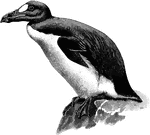
Great Auk
"This species (Alca impennis or Great Auk), extirpated chiefly by the persecution of fisherman, but…

Great Auk
"Alca Impennis. The Great Auk. A great white oval spot between eye and bill. Hood and mantle dark; under…

Parroquet Auk
"Simorhynchus psittaculus. Parroquet Auk. Pug-nosed Auk. Adult in summer with the nasal saddle, moulted…
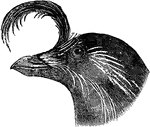
Whiskered Auk
"Simorhynchus pygmaeus. Whiskered Auk. Red-nosed Auk. Bill (dry) orange-red, more salmon color or yellow…

Young Horn-billed Auk
"Ceratorhina monocerata. Unicorn Auk. Horn-bill Auk. Young: Bill like that of adults in winter, lacking…

Young Whiskered Auk
"Simorhynchus pygmaeus. Whiskered Auk. Red-nosed Auk. Bill very small and weak, much compressed. No…

Auks and Cormorants
" A needle rock tenanted by Cormorants, Auks, etc." Elliot Coues, 1884 The rock is protruding from the…
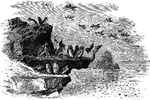
Least Auks
"Simorhynchus pusillus. Least Auk. Knob-nosed Auk. Bill small and simple, but stout for its length,…

Avocets Head and Foot
"Another small family, characterized by the extreme length of the slender legs, and the extreme slenderness…

Avocets
"Recurvirostra. Avocets. Bell slender, more or less recurved, then the upper mandible hooked at the…
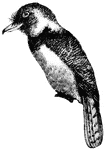
Barbet
Cuckoos have elegant shapes; beaks almost as long as the head, compressed, and slightly curved; the…

Barbs
"The arrangement shown in fig. 22, where a, a, a, a, are four barbs in transverse section, viewed from…
Single Barbule
"Fig. 21. -A single barbule, baring barbicels and hooklets; magnified; after Nitzsch. ...barbicels (another…
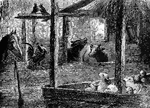
Barn Full of Animals
An illustration of a barn filled with animals, including: cows, a rooster, a horse, lambs, and birds.
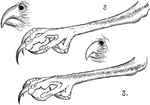
The Beaks and Claws of a Burrowing Owl
"Speotyto. Burrowing Owls. tarsi long, about twice as long as the middle toe without its claw, very…

Bell-Bird
"Chasmorhynchus niveus, the Bell-bird, ...have lores and orbits bare. The plumage is ordinarily plain…

Oriole Bill
"Icterus. Orioles. Bill averaging as long as head (more or less); very acute, sometimes decurved." Elliot…

Pelican Bill
"North American White Pelican. Bill and feet ordinarily yellow; much reddened in the breeding season,…
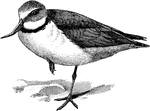
Wry-bill
Anarhynchus frontalis, the Wry-bill of New Zealand, is grey, with a black gorget and whitish lower parts;…
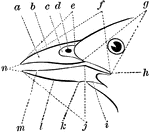
The Parts of a Bird Bill
"Fig. 26 - Parts of a Bill. a, side of upper mandible; b, culmen; c, nasal fossa; d, nostril; e(see…
